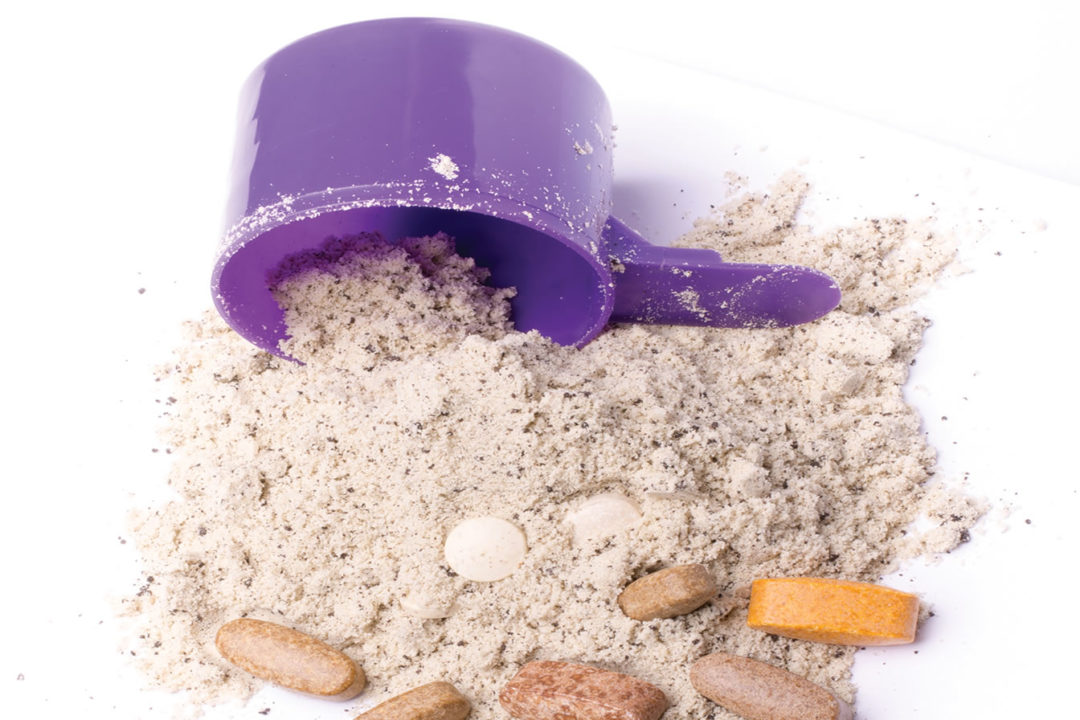Protein seems to be the latest sweetheart in nutrition and dieting; in recent years, we have all been bombarded with ads for high-protein snacks and quick-and-easy protein shakes. Is protein just a fad, though? It’s not likely, as this ingredient category has rightly earned its all-star status. Although a huge part of protein’s role in the body is muscle maintenance, protein has several other crucial responsibilities in the body.
Why Does The Body Need Protein?Besides muscle building and weight management, protein is involved in the formation of tendons, organs, skin, hormones, enzymes and neurotransmitters, and has several specific health benefits. Protein contains lactoferrin, beta-lactoglobulin, alpha-lactalbumin and immunoglobulin, all nutrients that help to lower blood pressure and blood sugar, to reduce symptoms of stress and depression, and increase mineral bone density (1).
Despite the other health benefits of protein, the health and fitness industry may be on to something with its promotion of protein. After all, protein increases strength, muscle gain and aids in healthy weight management (2).
In fact, protein can boost metabolism by up to 100 calories per day, and since it is the most filling macronutrient, it helps people consume as much as 441 fewer calories per day while still feeling full. This is the result of appetite-reducing hormones produced by proteins like GLP-1, PYY, CCK, and also the reduction of the hunger hormone Ghrelin. Just 20 g of protein per shake is enough to benefit from these hunger-reducing effects (2).
A study showed that eating protein for 25% of daily calories cut cravings by 60% and reduced late-night snacking by 50%. Studies have also shown that replacing other sources of calories with whey protein combined with lifting weights can lead to weight loss of up to eight pounds while increasing lean muscle mass. Since muscle burns more calories than fat, muscle gain helps to speed up the metabolism. The body also requires more calories to digest and metabolize protein because of the thermic effect of food, burning 15–30% of protein calories during digestion versus 5–10% of carbs and 0–3% of fats.
Not only does protein help stave off hunger, but its role in the production of lean muscle mass helps keep weight off. Protein is essential in the weight loss process because when you lose weight without adequate protein consumption, you burn muscle as well as fat, therefore slowing down the metabolism and making it easier to regain the weight. Studies have shown that a daily protein shake can make muscle maintenance up to three-and-a-half times more efficient. Other research has shown that those supplementing with protein during weight loss only regained 9% of their weight, whereas those who did not supplement with protein regained up to 23%.
How Much Protein Do We Need?The recommended minimum dose of protein is 0.34 g per pound of body weight, or between 25 and 50 g per day. However, the typical required amount of protein is 1 g of protein per pound body weight. Athletes and bodybuilders require even more protein, anywhere from 1.3 to 1.5 g of protein per pound body weight (2).
Although protein has many positive health benefits, excess protein is not necessarily beneficial to health. In a study of elderly individuals who were already consuming adequate protein, there was very little growth in muscle mass, suggesting that protein supplementation is most beneficial in the presence of a dietary deficit in this group. In addition, gratuitous protein still provides excess calories, which could lead to weight gain (2).
This is the most common negative effect of protein, but in some people, eating too much can cause digestive problems like nausea, flatulence, diarrhea, pain and cramping. Contrary to popular belief, protein has not been found to contribute to kidney damage, but those with current kidney or liver issues should consume lower amounts of protein (2).
Types of ProteinProtein supplements come from one of two sources: animal or plant protein. Whey and casein, the two main animal proteins, are different yet complementary. They tend to have greater protein benefits and taste, but plant-based proteins, including soy, hemp, rice, and pea, have their own nutritional benefits and can be good alternatives for those maintaining a vegan, vegetarian or lactose-free diet (3).
Whey.Whey protein, made from the liquid part of milk separated out in cheese production, is one of the best-studied supplements on the market. The most popular type of protein, whey tastes good and is a good value for the price. It has been found to promote immune health and weight loss and to suppress hunger.
Whey stimulates growth in humans. After all, 60% of breast milk is whey to stimulate healthy growth in babies, compared to only 20% in cow milk. This is because whey contains all essential amino acids, including branched-chain amino acids (BCAAs), which promote muscle growth. Among these BCAAs is leucine, the most anabolic growth-promoting amino acid. One study found that whey was three times more effective at maintaining muscle during weight loss compared to soy protein (3, 4).
The main difference between whey and another animal-based protein, casein, is that whey is absorbed quickly by the body. This allows whey’s muscle production benefits to begin quickly after consumption (3, 4).
Whey protein also comes in three forms with different benefits and tastes: concentrate, isolate and hydrolysate. Whey concentrate is anywhere from 70–80% protein. It has several dietary benefits because it retains most of the nutrients found in whey. It also has lactose (milk sugar) and fat, giving it a good taste, and these little amounts of fat and sugar are very small relative to daily intake. Whey isolate, on the other hand, is greater than 90% protein. Much of the lactose and fat is removed in production, along with several of the other nutrients. This keeps carbs and fat low, but creates a different taste and thinner consistency. Whey hydrolysate is predigested so that it absorbs faster, resulting in a 28–43% increase in insulin spike compared to isolate (3, 4).
Casein.Casein, another form of milk protein, differs from whey in its absorption rate. Like whey, casein contains all essential amino acids, promotes muscle production, and is tasteless when unsweetened or unflavored. Unlike whey, however, casein is absorbed slowly and creates an anabolic environment for muscle growth and maintenance. Casein is not readily soluble and forms micelles that slowly increase its solubility in water, therefore allowing it to be absorbed over a long period of time. In addition, casein experiences a delay in being transferred from the gastrointestinal tract to the blood, increasing absorption time as well (3, 4).
In one study, researchers gave subjects 30 g of either whey or casein and measured the anabolic and catabolic effect for seven hours after the meal. Those who consumed casein experienced a prolonged increase in blood amino acids that resulted in a 34% lower rate of protein breakdown, while those who consumed whey had no difference in muscle breakdown. Although whey may have created more muscle stimulation in the few hours immediately following supplementation, the net protein balance was more positive for casein after more time (3, 4).
Results like these support that although whey and casein can be beneficial on their own and will have the same net effects, together they may achieve an even better effect, maximizing the stimulation of muscle growth and minimizing breakdown.
Plant-based proteins.Plant-based protein, good alternatives to whey and casein for those with dietary restrictions, work through different channels than their animal-based counterparts. The most popular plant-based proteins are soy, hemp, rice and pea, but there are many on the market.
Soy protein, just like whey and casein, contains all essential amino acids. It also has soy isoflavones, which have antioxidant benefits. Although a good alternative to whey and casein, soy protein has a characteristic taste that can be difficult to mask with sweeteners. Hemp protein is high in omega-3 and omega-6 fats, but low in the essential amino acid lysine, as is protein from rice. Pea protein is low in the non-essential amino acids cystine and methionine (3).
If these proteins are being used supplementally and are not the only form of protein consumption, then these nutritional deficiencies are inconsequential. Some brands of these proteins, however, combine several of these plants to complement each other’s amino acid profile. Although made of different nutrient profiles promoting a host of different benefits, plant-based proteins are a good alternative to animal-based proteins for those with dietary restrictions (3).
When Should Protein Be Consumed?Timing can be very important to maximize the benefits of supplements, and protein is no exception. However, the optimal time to take protein varies based on the type. Because of its absorption speed and short-term benefits, whey can have the biggest impact just before and after a workout. These effects are short-lived, however, and a meal should be eaten within an hour of a post-workout protein shake. Whey may also be taken in the morning to quickly spur protein maintenance.
Casein, whey’s slow-acting counterpart, is best to take right before bed. This will promote a muscle-preserving environment throughout the night while no calories are consumed. When combining whey and casein, the ideal protein combination, supplementation an hour before and an hour after a workout allows the body to take advantage of both the immediate and prolonged benefits. Although muscle synthesis is at its peak after training, studies have found that the intake of protein is more important than the timing, so taking protein at other times is still better than forgoing it altogether (3, 4).
Check the Labels!It is very important to read the nutrition facts when choosing a brand of either animal- or plant-based proteins because some supplements have additives like sugar and other sweeteners. Supplements can either have artificial sweeteners, natural sweeteners, a combination of the two, or neither. Although the flavoring has no effect on the nutritional value of the protein, it can add extra calories. Be sure to alert customers to the nutrition of supplement flavoring when discussing their protein needs.WF
Paige Lazar is a freelance writer based in Mendham, NJ.
References1. K. Gunnars, “Whey Protein 101: The Ultimate Beginner’s Guide,”www.authoritynutrition.com.2. A. Petre, “How Protein Shakes Help You Lose Weight and Belly Fat,”www.authoritynutrition.com.3. M.G. Taylor, “Choosing a Protein Powder,”www.nutritionexpress.com.
4. J.S. Volek, “Whey vs. Casein Protein,” www.nutritionexpress.com.
Published in WholeFoods Magazine November 2016









